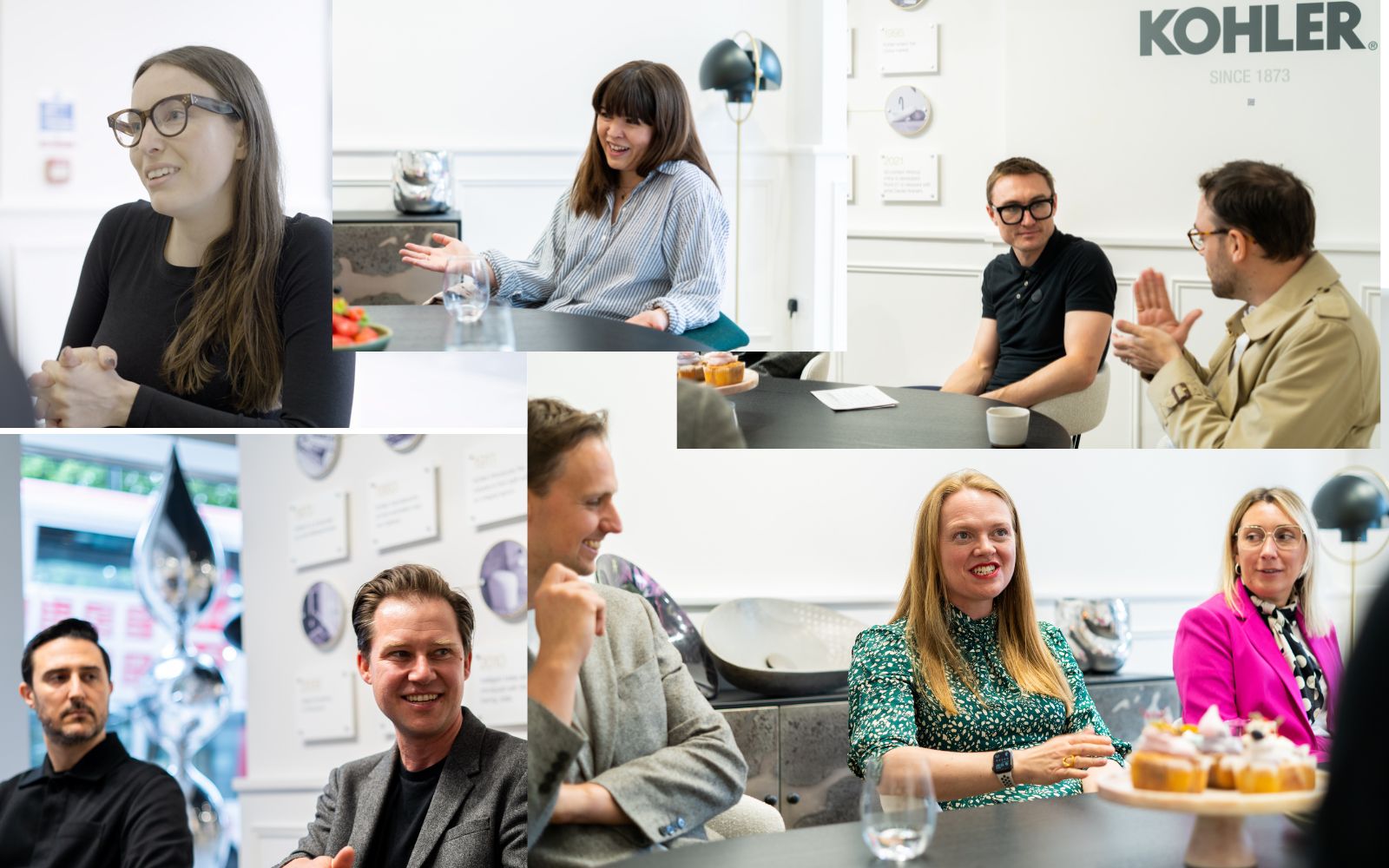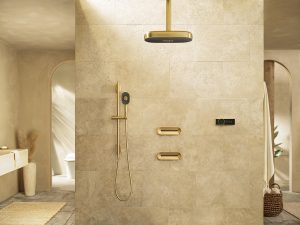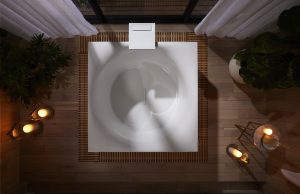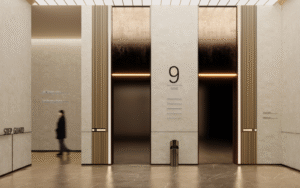Amidst the design laden schedule of Clerkenwell Design Week, Editor Hamish Kilburn, in association with Kohler, found time to sit down at a table with a group of leading designers to discuss the path that technology is – or should be – heading in the realm of wellness and intuitive bathroom design…

Thoughts on technology in the bathroom can usually be divided into two distinct camps; those who embrace it, and those who see the bathroom as a sanctuary, a place to escape technology. But, is there space in hospitality design for a middle ground? Can technology be used in a sensitive and subtle way to enhance the wellness experience, embedded within, rather than added on? Framing the conversation in the Kohler Experience Centre in the heart of London’s Clerkenwell neighbourhood, it felt appropriate to be discussing technology in the bathroom while surrounded by design by a bathroom brand moving sensitively into the digital space.
On the panel:
- Chuck Dedeu, Design Principal, 1508 London
- Claire Walduck, Senior FF&E Designer, GA Group
- Jo Littlefair, Co-Founder, Goddard Littlefair
- Jane Maciver, Creative Director, BuckleyGrayYeoman
- Henry Reeve, Head of Interior Design, InterContinental Hotels Group (IHG)
- Joseph Troughton, Senior Designer, David Collins Studio
- Simon Kincaid, Partner, Conran & Partners
- Lauren Hughes Glass, Associate Interior Designer, ICA Studio
As home bathrooms are getting bigger and more intuitive, the hospitality industry would fall behind if it didn’t identify what a hotel can offer that is more than what we have seen or experienced before. Bathrooms have to work harder, while at the same time look sophisticated and have a design edge, as they are increasingly the hero in the hotel guestroom experience.
As the discussion rolled out, the panel soon reached consensus on the fact that while it is important to give the guest an enhanced experience, it is as important to look carefully at how and where technology is injected into design. A guest experience of technology in the bathroom should be an intuitive one, rather than something that needs to be confronted. “Our lives are already complicated, balancing family, work and social,” said Jo Littlefair, Co-Founder, Goddard Littlefair who took the position that technology needs to assist design rather than dictate to it. “So for me I don’t want to over complicate things, but would love to see a more intuitive experience in the bathroom – technology that actually works, that can be used as much or as little as we want to.”

Image credit: Kohler
What was agreed on by the panel was the importance of technology behind the tiles.; the technology that works to make things more efficient, more sustainable, and in fact easier for the user. With this in the forefront, Henry Reeve, Director of Interior Design, IHG, believed that this conversation really should be about balance. “There is then a need to balance technology with design,” he said. “Everything needs to work together to create the whole package.” Successful technology adds to the experience, sometimes without even being noticed. “Where I see technological advancements as a positive, is when it enhances our ability to be more sustainable without impacting the user experience, added Littlefair. “Products like these allow the designer to focus on a more curated experience.”

Image credit: Kohler
To integrate technology successfully and seamlessly into a design we need to explore it on all levels – it can be quite simple, like underfloor heating, good lighting, a de-mister in the mirror. “We are seeing hotels include subtle add-ons that elevate the experience without leaving guests feeling like they need to be an IT expert to turn on the shower,” said Joseph Troughton, Senior Designer, David Collins Studio. “It is instead about finding solutions that elevate the experience rather than a technology based gimmick that will receive short term interest but will ultimately date and reduce the lifespan of a design, rather than enhance it.”
With debate around levels of technology a user or guest might be comfortable with, it was felt that design should be used to curate the experience and to ensure that the balance between technology and experience is maintained. “Technology should be in the functionality of the bathroom and should make life easier rather than over complicate our already complicated and technology driven lives,” explained Kincaid. “Looking to the future, there is the ambition to be able to personalise technology in the bathroom to simplify, to create an experience that is able to tread the line between invasive and inventive.”
“A hotel is an unfamiliar space, and as a designer it is important not to make a guest feel unintelligent,” said Jane Maciver, Creative Director, BuckleyGrayYeoman. “If it is all too complicated and they have to ask how to turn the shower on, you’ve lost them. Technology works best [in a hotel setting] when it is really seamless, intuitive, and present without even being noticed.”

Image credit: Kohler
With the bathroom increasingly the focal point in the guestroom rather than a practical necessity or add-on, tucked away in wardrobe-like proportions, spaces are getting bigger in response to guest expectations. “Bringing a wellness and a spa experience into the bathroom has become key, and along with this, the luxury of space,” explained Chuck Dedeu, Design Principal, 1508 London. “This has become the ultimate luxury in the bathroom and one which is changing the demands and design specifications of not only bathrooms but the guestroom and suite as a package.”
Of course, with the standard hotel bathrooms larger and given more of an emphasis, this opens up opportunities to take these spaces beyond practical spaces. “Bringing in the wellness aspect is really starting to shift what we can do in the space, and is a great opportunity to take the bathroom to another level,” added Claire Walduck, Senior FF&E Designer, GA Group.

Image caption: The Stillness bath is Kohler’s answer to a premium sensory design experience in the bathroom. | Image credit: Kohler
Technology is and will continue to be integrated into successful bathroom design, but the how and what is a matter of both nuance and opinion. It is about balance. Balance between gimmick versus longevity versus elevation. With longevity increasingly becoming the pivot around which discussions on sustainability hinge, technology needs to be considered to ensure it doesn’t date a design.
While the panellists might have had different ideas of the level of technology they were comfortable with, and there was some hesitation when discussing how far to move in the direction of digitalisation in the bathroom, it was agreed by everyone on the panel that where technology unquestionably has a role to play is in the production of materials and surfaces that are more sustainable in the bathroom.
With the pace that technology is developing, it needs to be considered carefully within the debate on longevity of design. Technology can instantly date a room and does tend to need replacing, which can detract from its design appeal. However, again it was felt that designers need to curating the level of technology. “Clever design can get around a lot of the problems, where you recognise that you have technology that will need replacing, don’t build it in in a way that is not replaceable,” advised Lauren Hughes Glass, Associate Interior Designer, ICA.
Bathrooms are, by design and purpose, used in a very routine way which presents technology with the opportunity of directing and enhancing these everyday routines. For some it is a place where guests can detach from technology, while others are happy to embrace it. It might be the place to catch up with Alexa about your schedule, or the sanctuary to soak away the day in some in Himalayan salt – and a good design should be able to integrate both these roles. How this is integrated into design needs to be a considered and a natural progression rather than something imposed on the user. In short, we need to be smart about how we use technology to ensure that it contributes to the design, experience, and finally longevity.
Kohler have recently launched its new digital showering collections, Statement and Anthem, ensuring that technology in the bathroom is driven by both design and concepts of wellness.
Kohler is one of our Recommended Suppliers and regularly features in our Supplier News section of the website. If you are interested in becoming one of our Recommended Suppliers, please email Katy Phillips.
Main image credit: Hotel Designs






















